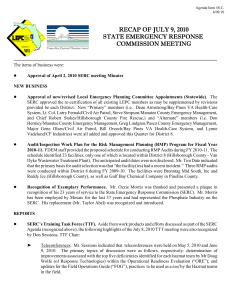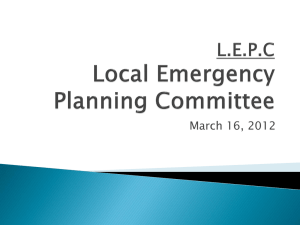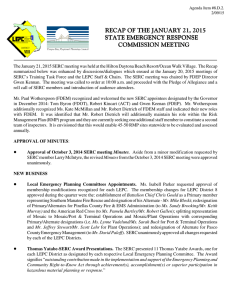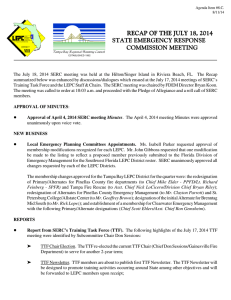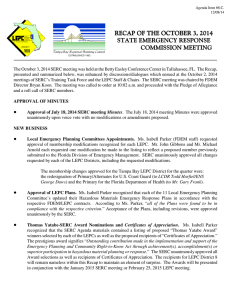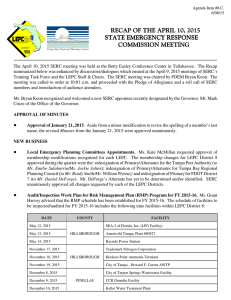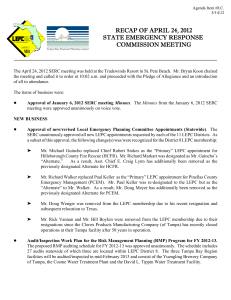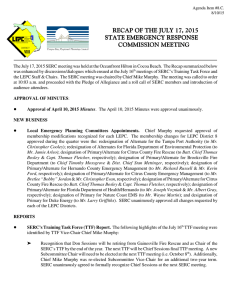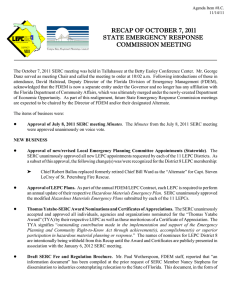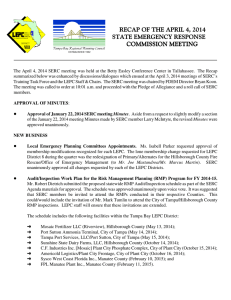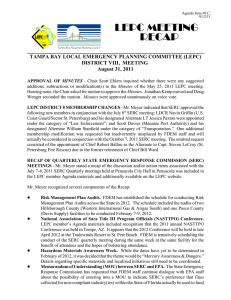RECAP OF THE JULY 12, 2013
advertisement
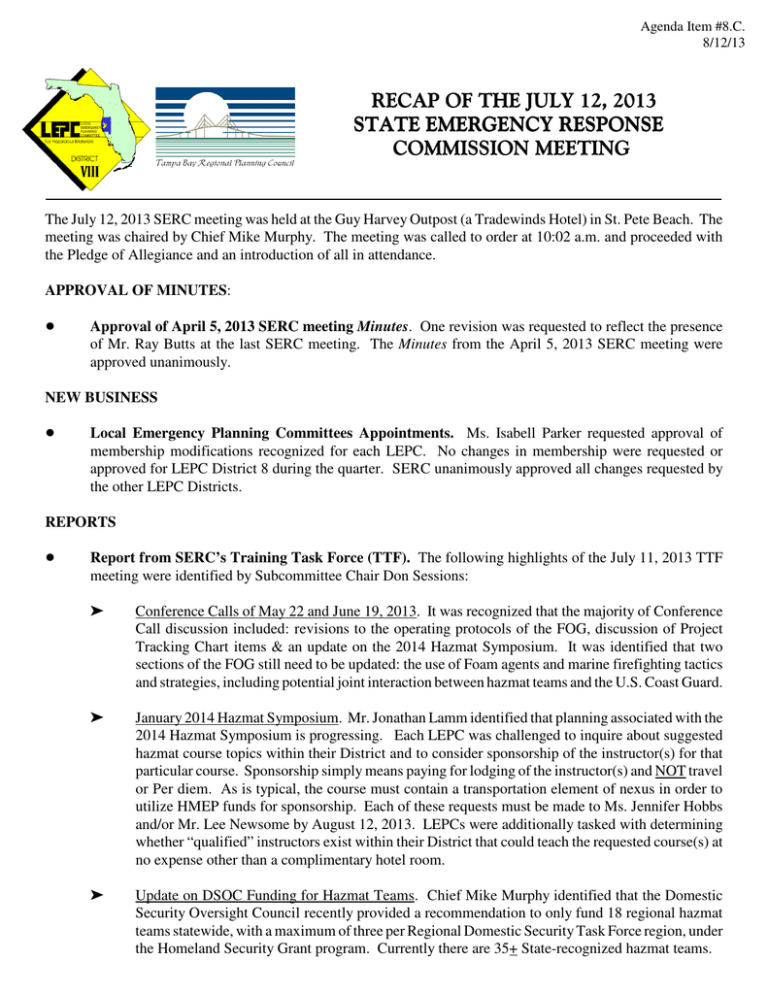
Agenda Item #8.C. 8/12/13 RECAP OF THE JULY 12, 2013 STATE EMERGENCY RESPONSE COMMISSION MEETING The July 12, 2013 SERC meeting was held at the Guy Harvey Outpost (a Tradewinds Hotel) in St. Pete Beach. The meeting was chaired by Chief Mike Murphy. The meeting was called to order at 10:02 a.m. and proceeded with the Pledge of Allegiance and an introduction of all in attendance. APPROVAL OF MINUTES: ! Approval of April 5, 2013 SERC meeting Minutes. One revision was requested to reflect the presence of Mr. Ray Butts at the last SERC meeting. The Minutes from the April 5, 2013 SERC meeting were approved unanimously. NEW BUSINESS ! Local Emergency Planning Committees Appointments. Ms. Isabell Parker requested approval of membership modifications recognized for each LEPC. No changes in membership were requested or approved for LEPC District 8 during the quarter. SERC unanimously approved all changes requested by the other LEPC Districts. REPORTS ! Report from SERC’s Training Task Force (TTF). The following highlights of the July 11, 2013 TTF meeting were identified by Subcommittee Chair Don Sessions: ' Conference Calls of May 22 and June 19, 2013. It was recognized that the majority of Conference Call discussion included: revisions to the operating protocols of the FOG, discussion of Project Tracking Chart items & an update on the 2014 Hazmat Symposium. It was identified that two sections of the FOG still need to be updated: the use of Foam agents and marine firefighting tactics and strategies, including potential joint interaction between hazmat teams and the U.S. Coast Guard. ' January 2014 Hazmat Symposium. Mr. Jonathan Lamm identified that planning associated with the 2014 Hazmat Symposium is progressing. Each LEPC was challenged to inquire about suggested hazmat course topics within their District and to consider sponsorship of the instructor(s) for that particular course. Sponsorship simply means paying for lodging of the instructor(s) and NOT travel or Per diem. As is typical, the course must contain a transportation element of nexus in order to utilize HMEP funds for sponsorship. Each of these requests must be made to Ms. Jennifer Hobbs and/or Mr. Lee Newsome by August 12, 2013. LEPCs were additionally tasked with determining whether “qualified” instructors exist within their District that could teach the requested course(s) at no expense other than a complimentary hotel room. ' Update on DSOC Funding for Hazmat Teams. Chief Mike Murphy identified that the Domestic Security Oversight Council recently provided a recommendation to only fund 18 regional hazmat teams statewide, with a maximum of three per Regional Domestic Security Task Force region, under the Homeland Security Grant program. Currently there are 35+ State-recognized hazmat teams. Chief Murphy iterated the following concerns which should be contemplated and addressed, to the appropriate extent, prior to potentially consolidating or deactivating hazmat teams: ! ! ! ! ! need to conduct a Comprehensive Threat and Vulnerability Assessment prior to any reduction in hazmat teams. This Assessment could/would include the location of such targets as radiological facilities, population concentrations, bulk chemical storage facilities, military bases, pipelines...; the requested reduction appears to be arbitrary in number with no justification provided; alternatively to the reduction in the number of hazmat teams, funds should be provided to each Region and allow the further funding disbursement at the local level upon consensus. That way all hazmat teams could be ensured some funding; need to ensure that residents and industry will remain safe and that incidents can and will be responded to in a reasonable time period if hazmat teams are to be eliminated; and identification of what happens to existing hazmat team equipment/personnel of deactivated teams. Chief Murphy reminded SERC members that the SERC developed the standards and criteria for regional hazmat teams in the early 1990s and designated most of their numbers and locations in order to ensure ample protection. That way, hazmat equipment and capabilities would be in close proximity to any/all hazmat incidents. Most of the hazmat team funding was initially and remains at the local level. A motion was made, seconded and approved unanimously to send a letter to the Chair of the Domestic Security Oversight Council (Bryan Koon), with a copy provided to the Governor, requesting that progress towards reducing the number of regional hazmat teams be immediately halted until a Comprehensive Threat and Vulnerability Assessment has been conducted and evaluated to justify such reduction. ' ! Next Training Task Force teleconferences. The next series of TTF teleconferences were announced to be August 21st & September 18th, both at 1:30 p.m. Report on Use of E-Plan as a Tier II Reporting Tool. Mr. Paul Wotherspoon (FDEM staff) provided the following highlights regarding promotion of the E-Plan system as a means for electronic reporting: ' ' ' ' The State’s prior electronic Tier II reporting program (FloridaHMIS.org) was difficult for industry to enter their data and for FDEM staff to manipulate and/or print desired reports, hence only 46 percent of all facilities filed electronically last year, after three years of promotion and effort. The State’s current electronic filing option (E-Plan) was opened on January 18th and has yielded an outstanding participatory rate of 78% in the first year! The State optimistically anticipates electronic filing rates of 90%+ for all Tier II facilities in the coming years. Some of the benefits derived from filing electronically through E-Plan include: the fact the data is available instantaneously by the first responders; the facility would not be required to submit their 2 ' Tier II reports to the SERC and additionally may no longer be required to submit their Tier II data to the LEPC and local fire departments; database will soon be able to be sorted by the SERC, the LEPCs, and by first responders; much easier for facilities to update their reporting annually; there is a corresponding link to electronic payment of filing fees; and enhancements are ongoing within the E-Plan program for such capabilities as plume modeling. Mr. Wotherspoon indicated that the University of Texas at Dallas correspondence indicating the potential demise of E-Plan due to lack of funding was not necessarily warranted. Florida and other States see the benefit of E-Plan and will continue to fund its existence, at least for its implementation within Florida. UTD had mentioned the possibility of charging facilities a E-Plan utilization fee. If so, Florida will pay those costs since facilities already pay registration fees. Cost to operate the system is less than $1M annually. A motion was made, seconded and approved unanimously to send a letter of support for the E-Plan program as well as the recommendation for continued funding from the SERC to the Governor. ! Financial Status Report. Mr. Wotherspoon reported that the SERC Agenda materials contained numerous tables and graphs depicting a comparison of the various revenues and expenditures associated with FDEM’s Hazardous Materials Planning and Risk Management Planning Programs over the past two years. The numbers are nearly the same. Graphics were provided in the Agenda materials to quantify and illustrate: ' ' ' ! Revenues received by Month for RMP & EPCRA programs since mid-FY 2010-11; Breakdown of General Appropriations and Expenditures by Category for the Hazardous Materials Planning Program for FYs 2011-12 & 2012-13; and Breakdown of General Appropriations and Expenditures by Category for the Risk Management Planning Program for FYs 2011-12 & 2012-13 Hazardous Materials Incidents Reports. Mr. Sam Brackett advised that detailed listings of Section 304 investigation, as well as fixed facility and transportation-related hazardous materials incidents were prepared and included with the Agenda materials to describe incidents occurring between the period of March 1 - May 31, 2013. Such Reports included documentation of these incidents and portrayed the number of persons evacuated, injured or deceased down to LEPC District and ultimately County level. The following constitute the hazardous material incidents recorded for District 8 during this period, including an enumeration of those evacuated, injured or deceased: County Date of Release 3/09/13 Hillsborough Type* 304 (Closed) Chemical Sulfuric Acid Amount Released (Lbs.) Business Type 998 Phosphate Mining # Evacuated # Injured # Fatalities N/A N/A N/A 3/15/13 TR Natural Gas Unknown Traffic Accident 1 0 0 3/29/13 TR Natural Gas Unknown Traffic Accident 1 0 0 4/05/13 FF/304 Freon or Phosgene Unknown A/C Repair 20 2 0 (Closed) 3 County Date of Release 4/09/13 Hillsborough Type* 304 (Closed) Chemical Amount Released (Lbs.) Business Type Mining # Fatalities N/A N/A N/A 0 7 0 Phosphoric Acid 4,598 Hydrogen Sulfide Unknown Construction School 90 37 0 FF/304 5/03/13 FF Pepper Spray Unknown 304 Sodium Hypochlorite 883 Wastewater Plant N/A N/A N/A Sodium Hypochlorite 506 College N/A N/A N/A 5/30/13 (Closed) (Closed) 304 (Closed) 4/04/13 TR Gasoline or Oil or Diesel 4/26/13 TR Diesel Fuel 304 Lead/Mercury Unknown Traffic Accident 0 1 0 740 Traffic Accident 0 1 0 N/A N/A N/A 11 0 0 TOTAL º 123 48 KEY: FF = Fixed Facility incident / TR - Transportation-related incident / 304 - Section 304 Investigation Launched (Status) 0 Manatee 5/06/13 (Closed) Unknown Grow House Pasco Pinellas NONE 4/30/13 TR Natural Gas Unknown Traffic Accident Update on Staff Activities and Reports by Section. Mr. Tim Date identified that various graphics were provided within the SERC Agenda materials to depict various staff functions and initiatives. These included: ' ' ' ' ' ! # Injured 4/11/13 5/06/13 ! # Evacuated monthly enumeration of Hazardous Materials Incident Reports since 2003; Total Facility Count by LEPC (as of 5/31/13); quantification of Notice of Violations issued statewide for over the past year; monthly quantification of Technical Assistance calls received from June 2012 - May 2013; and enumeration of Tier 2 Data by Year since 2010 in terms of the # of facilities and the # of chemicals. Update on LEPC Activities. Subcommittee Chair Jennifer Hobbs provided a briefing of the items discussed at yesterday’s LEPC Staff & Chairs meeting. The items included: ' Jennifer Hobbs indicated that there were several revisions to this year’s annual allotment of Hazards Analyses contracts (HAs), most of which were clarifications (e.g. update of release duration period, recognition that some chemicals are liquid in their normal state but turn to gas upon releases...). Attendance at one of the statewide Hazards Analyses training workshops, as conducted by FDEM staff, is a pre-requisite for anyone accepting State funding for the conduct of the HAs. ' Mr. Mark Tumlin (SERC member) indicated that the Agriculture industry is interested in getting more involved with the LEPC Districts statewide (and SERC) following the West Fertilizer Company incident. Mr. Tumlin agreed to transmit the contact information of interested parties to the appropriate LEPC for immediate notification of future meetings. The LEPCs welcomed the expanded relationship with the industry but encouraged interested party(ies) to attend a few meetings to ensure a good fit before seeking to expand the LEPC membership rosters. If, in the future, corresponding membership is granted, it could appropriately occur the “Local Option” or “Facility Owners/Operators” categories. 4 ' Mike Murphy (SERC member) requested that the creation of the Supplemental Environmental Projects (SEPs) website be expedited and linked to the SERC web page. The funding of a SEP(s) is an option extended to facilities found to be in violations with the Emergency Planning and Community Right to Know Act (EPCRA) in lieu of full fine payments. Mr. Murphy mentioned that “with each passing day without a SEP program, the State may have lost an opportunity to potentially funding valuable and needed resources.” While potential SEPs continue to be solicited statewide and should have varying implementation costs, a SEP could fund the interface of the State’s program. It is envisioned that the Florida’s SEP website, once created, will be patterned after the one implemented for Illinois for its ease of use, ingenuity and intuitiveness. That website is: www.epa.state.il.us/enforcement/sep. A motion was made, seconded and approved unanimously to send a letter requesting the expedition of Florida’s database creation to Director Bryan Koon. As an industry representative, Mr. Mark Tumlin recognized that industries would prefer positive use of fines rather than winding up as general funds for the federal government. ' Ms. Hobbs concluded her remarks by recognizing that the amount of training & activities going on across the State is incredible and identified that a summary of these activities is documented each quarter in the Hazmatters section of the SERC Agenda materials. The following serve as the documented tasks identified by LEPC District 8 staff for the period of March - May 2013: • District 8 LEPC staff was involved in a number of activities during the quarter. Staff attended the SERC quarterly meetings held at the Betty Easley Conference Center in Tallahassee on April 4-5, 2013, as well as a meeting to discuss the status of the Hazards Analyses program (April 3rd). The District 8 LEPC quarterly meeting was held on May 29th. Staff and members of the LEPC attended the FDEM Region 4 quarterly meeting on March 1st at the offices of the Tampa Bay Regional Planning Council under the leadership of FDEM Region 4 Coordinator Paul Siddall. In addition, LEPC staff and/or member(s) also participated in the March 20th teleconference administered by FDEM staff Lou Ritter regarding the TTF's update to the Hazmat FOG. • The LEPC's Facility Disaster Planning Subcommittee (FDPS) met on April 17th. The primary discussion items included: an update on the SERC/EPA Supplemental Environmental Projects program; and the upcoming "Keeping Your Head above Water: Storm Surge Preparedness for Businesses with Hazardous Materials Workshop" scheduled for June 27th. Workshop topics will consist of: "Storm Surge 101" and identification of Meteorological Trends; Identification of Vulnerabilities & Chemical Storage; Have a Plan; Insurance & Financial Issues; and Lessons Learned. Being held in conjunction with the Tampa Port Authority, the workshop is designed to provide information to assist hazardous materials facility operators in determining the most appropriate course of action regarding their inventories when a significant storm event is approaching or imminent. This would/could include potentially "topping off" the storage tanks for stability and structural integrity or transporting the hazardous materials out of the more vulnerable areas. As learned from numerous past Hurricanes, facilities do not have to be located immediately adjacent to the coastline to be subject to storm surge and considerable damage. It is anticipated that, once conducted, the workshop will count towards the HMEP Planning project of Community Outreach/Workshops. 5 • The LEPC's HMEP Training Subcommittee met on May 29th. As would be/is appropriate, discussion revolved around desired training opportunities and needs across the Region as well as addressing the caveat that 25% of next year's HMEP Training funds will need to be spent in the first quarter alone (i.e. July 1 – Sept. 30). During the present quarter, three 8-Hr. Chlorine Refresher courses were conducted for the Pinellas County Hazmat Team (April 23-25) and ten members of Pasco County Fire Rescue and St. Petersburg Fire Rescue were sent to a 40-Hr. HazMedic course conducted by LEPC District 5 in Ocala (May 13-17). Following the conduct of three 8-Hr. Hazmat IQ courses (scheduled for June 23-25), the remaining 2012-13 HMEP Training funds will have been expended. The pre-requisites HMEP Training funds remain that the course: must be intended for public-sector First Responders; must be pre-approved and deemed "cost effective" by FDEM staff; and, at minimum, must include a transportation component or nexus. • In terms of miscellany, LEPC staff additionally: hosted meetings of the Preventative Radiological Nuclear Detection Committee (March 7th & April 18th); facilitated the monthly meetings of the Pinellas Police Standards Council (March 13th, April 10th & May 8th); attended the bi-monthly of the Tampa Bay Spill Committee meeting (March 12th & May 14th); attended the U.S. Coast Guard's Area Contingency Planning meeting (March 12th); provided a presentation entitled "the Role of the LEPCs" to the Tampa Cooperative Safety Initiative Committee (March 19th); attended the monthly meeting of the Ammonia Handlers/Operators (March 26th, April 23rd & May 21st); participated in planning scenario meetings associated with the future conduct of a "Hazardous Materials Forum" primarily for the business tenants within the Port of Tampa (March 26th & April 23rd); prepared and submitted LEPC & HMEP Quarterly Reports (April 29th); transmitted an "E-Plan Letter of Support" to FDEM staff as well as the entire Tampa Bay area legislative delegation and Florida contingency of federal representatives (May 29th); and submitted applicable LEPC Membership Nominations forms (June 3rd) & Hazmatters report (June 5th) in preparation for the July 12th SERC meeting. OTHER BUSINESS ! Fertilizer Industry in Florida Presentation. Ms. Mary Hartney, President of Florida Fertilizer and Agrichemical Association. Ms. Hartney provided a presentation signifying that Florida is home to one of the largest Fertilizer and agrichemical businesses in the nation and world and its nearly immeasurable benefits to Florida’s economy in the primary and secondary markets. The presentation and the heightened interest in coordination with the SERC and the LEPCs are in response to West Fertilizer Company Texas tragedy. West Fertilizer was in operation since 1962 and was purchased by a farmer (Donald Adair), not a retailer. The facility stored about 100,000 pounds of anhydrous ammonia, 270 tons of ammonium nitrate, bulk pesticides, seed & grain. It is unknown whether full regulatory compliance would have prevented the West Fertilizer Co. incident. Federal authorities are still trying to determine the cause of the initial fire, whether it be a fault in the 120V electrical system, a golf cart, or arson. Fertilizer is responsible for about 50% of world’s food production. Each type of fertilizer has different uses and risks. Local facilities have encouraged tours of their facilities by local emergency responders, fielded numerous media inquiries and answered questions from neighbors. An on-line self assessment and regulation tool is available at the following link: www.asmark.org/complianceassessmenttool. Retail facilities do have an AG exemption although they would still require sprinklers and ventilation of buildings. Subsequent to Texas explosion, there has been an initiative for the development of standards for handling of anhydrous ammonia (e.g. assist with regulatory compliance, better documentation of company policies, employee training, lower safety & environmental incidents...). The industry continue to make strides towards working with government and others to manage the risks inherent to the industry. Federal legislator 6 Barbara Boxer, Chair of Environmental subcommittee, held a public hearing and encouraged all Governors to promote safety measures within their States. Ammonium Nitrate facilities with inventories greater than 10,000 pounds must report annually. ! Transportation Community Awareness and Emergency Response (TRANSCAER) Update. Mr. Paul Wotherspoon identified that training will be provided by the Chlorine Institute on August 14-15, 2013 in Fernadina Beach. Training regarding Chlorine, Ethanol & Anhydrous Ammonia will be provided at the Florida State Fire College on September 10-13, 2013. Lodging at the Fire College will be made available on a space-permitting basis and food will be provided by the Chlorine Institute. Mr. Wotherspoon has inquired as to desired vendors for the latter event. Ms. Kate Boer suggested contacting the same vendors that attended last year’s Fire Rescue East conference. COMMENTS & ADJOURNMENT. ! Next Meeting. It was announced that the next SERC meeting will be held in Tallahassee (or an alternate venue) on October 4, 2013. ! Adjournment. The SERC meeting was adjourned at 12:05 p.m. 7
